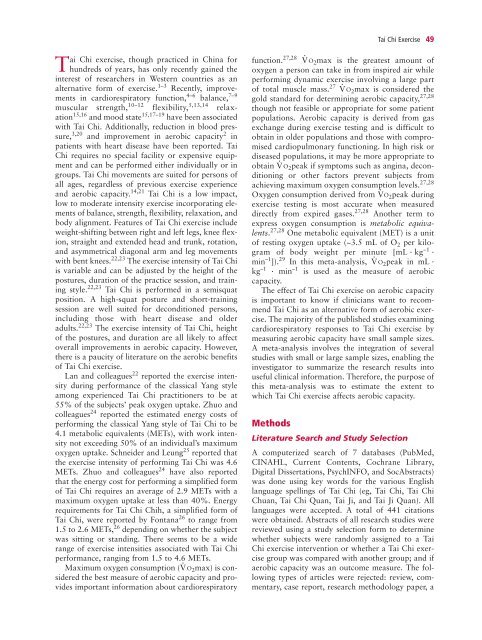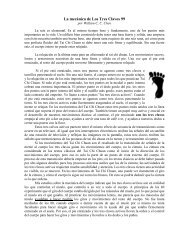The Effectiveness of Tai Chi Exercise in Improving Aerobic Capacity
The Effectiveness of Tai Chi Exercise in Improving Aerobic Capacity
The Effectiveness of Tai Chi Exercise in Improving Aerobic Capacity
You also want an ePaper? Increase the reach of your titles
YUMPU automatically turns print PDFs into web optimized ePapers that Google loves.
<strong>Tai</strong> <strong>Chi</strong> <strong>Exercise</strong> 49<br />
<strong>Tai</strong> <strong>Chi</strong> exercise, though practiced <strong>in</strong> <strong>Chi</strong>na for function. 27,28 V .<br />
O 2 max is the greatest amount <strong>of</strong><br />
hundreds <strong>of</strong> years, has only recently ga<strong>in</strong>ed the oxygen a person can take <strong>in</strong> from <strong>in</strong>spired air while<br />
performance, rang<strong>in</strong>g from 1.5 to 4.6 METs.<br />
Maximum oxygen consumption ( V . cise group was compared with another group; and if<br />
O 2 max) is considered<br />
aerobic capacity was an outcome measure. <strong>The</strong> follow<strong>in</strong>g<br />
<strong>in</strong>terest <strong>of</strong> researchers <strong>in</strong> Western countries as an perform<strong>in</strong>g dynamic exercise <strong>in</strong>volv<strong>in</strong>g a large part<br />
alternative form <strong>of</strong> exercise. 1–3 Recently, improvements<br />
<strong>of</strong> total muscle mass. 27 V .<br />
O 2 max is considered the<br />
<strong>Chi</strong> requires no special facility or expensive equipment<br />
and can be performed either <strong>in</strong>dividually or <strong>in</strong> obta<strong>in</strong> V . O 2 peak if symptoms such as ang<strong>in</strong>a, decon-<br />
diseased populations, it may be more appropriate to<br />
<strong>in</strong> cardiorespiratory function, 4–6 balance, 7–9 gold standard for determ<strong>in</strong><strong>in</strong>g aerobic capacity, 27,28<br />
muscular strength, 10–12 flexibility, 5,13,14 relaxation<br />
though not feasible or appropriate for some patient<br />
15,16 and mood state 15,17–19 have been associated<br />
with <strong>Tai</strong> <strong>Chi</strong>. Additionally, reduction <strong>in</strong> blood pressure,<br />
populations. <strong>Aerobic</strong> capacity is derived from gas<br />
exchange dur<strong>in</strong>g exercise test<strong>in</strong>g and is difficult to<br />
3,20 and improvement <strong>in</strong> aerobic capacity 2 <strong>in</strong> obta<strong>in</strong> <strong>in</strong> older populations and those with compro-<br />
patients with heart disease have been reported. <strong>Tai</strong> mised cardiopulmonary function<strong>in</strong>g. In high risk or<br />
groups. <strong>Tai</strong> <strong>Chi</strong> movements are suited for persons <strong>of</strong> dition<strong>in</strong>g or other factors prevent subjects from<br />
all ages, regardless <strong>of</strong> previous exercise experience achiev<strong>in</strong>g maximum oxygen consumption levels. 27,28<br />
and aerobic capacity. 14,21 <strong>Tai</strong> <strong>Chi</strong> is a low impact, Oxygen consumption derived from V .<br />
O 2 peak dur<strong>in</strong>g<br />
low to moderate <strong>in</strong>tensity exercise <strong>in</strong>corporat<strong>in</strong>g elements<br />
<strong>of</strong> balance, strength, flexibility, relaxation, and directly from expired gases. 27,28 Another term to<br />
exercise test<strong>in</strong>g is most accurate when measured<br />
body alignment. Features <strong>of</strong> <strong>Tai</strong> <strong>Chi</strong> exercise <strong>in</strong>clude express oxygen consumption is metabolic equivalents.<br />
One metabolic equivalent (MET) is a unit<br />
weight-shift<strong>in</strong>g between right and left legs, knee flexion,<br />
straight and extended head and trunk, rotation, <strong>of</strong> rest<strong>in</strong>g oxygen uptake (~3.5 mL <strong>of</strong> O 2 per kilogram<br />
<strong>of</strong> body weight per m<strong>in</strong>ute [mL · kg –1 ·<br />
and asymmetrical diagonal arm and leg movements<br />
with bent knees. 22,23 <strong>The</strong> exercise <strong>in</strong>tensity <strong>of</strong> <strong>Tai</strong> <strong>Chi</strong> m<strong>in</strong> –1 ]). 29 In this meta-analysis, V . O 2 peak <strong>in</strong> mL ·<br />
is variable and can be adjusted by the height <strong>of</strong> the kg –1 · m<strong>in</strong> –1 is used as the measure <strong>of</strong> aerobic<br />
postures, duration <strong>of</strong> the practice session, and tra<strong>in</strong><strong>in</strong>g<br />
style. 22,23 <strong>Tai</strong> <strong>Chi</strong> is performed <strong>in</strong> a semisquat<br />
position. A high-squat posture and short-tra<strong>in</strong><strong>in</strong>g<br />
session are well suited for deconditioned persons,<br />
<strong>in</strong>clud<strong>in</strong>g those with heart disease and older<br />
adults. 22,23 <strong>The</strong> exercise <strong>in</strong>tensity <strong>of</strong> <strong>Tai</strong> <strong>Chi</strong>, height<br />
<strong>of</strong> the postures, and duration are all likely to affect<br />
overall improvements <strong>in</strong> aerobic capacity. However,<br />
there is a paucity <strong>of</strong> literature on the aerobic benefits<br />
<strong>of</strong> <strong>Tai</strong> <strong>Chi</strong> exercise.<br />
Lan and colleagues 22 reported the exercise <strong>in</strong>tensity<br />
dur<strong>in</strong>g performance <strong>of</strong> the classical Yang style<br />
among experienced <strong>Tai</strong> <strong>Chi</strong> practitioners to be at<br />
capacity.<br />
<strong>The</strong> effect <strong>of</strong> <strong>Tai</strong> <strong>Chi</strong> exercise on aerobic capacity<br />
is important to know if cl<strong>in</strong>icians want to recommend<br />
<strong>Tai</strong> <strong>Chi</strong> as an alternative form <strong>of</strong> aerobic exercise.<br />
<strong>The</strong> majority <strong>of</strong> the published studies exam<strong>in</strong><strong>in</strong>g<br />
cardiorespiratory responses to <strong>Tai</strong> <strong>Chi</strong> exercise by<br />
measur<strong>in</strong>g aerobic capacity have small sample sizes.<br />
A meta-analysis <strong>in</strong>volves the <strong>in</strong>tegration <strong>of</strong> several<br />
studies with small or large sample sizes, enabl<strong>in</strong>g the<br />
<strong>in</strong>vestigator to summarize the research results <strong>in</strong>to<br />
useful cl<strong>in</strong>ical <strong>in</strong>formation. <strong>The</strong>refore, the purpose <strong>of</strong><br />
this meta-analysis was to estimate the extent to<br />
which <strong>Tai</strong> <strong>Chi</strong> exercise affects aerobic capacity.<br />
55% <strong>of</strong> the subjects’ peak oxygen uptake. Zhuo and<br />
colleagues 24 reported the estimated energy costs <strong>of</strong><br />
perform<strong>in</strong>g the classical Yang style <strong>of</strong> <strong>Tai</strong> <strong>Chi</strong> to be<br />
4.1 metabolic equivalents (METs), with work <strong>in</strong>tensity<br />
not exceed<strong>in</strong>g 50% <strong>of</strong> an <strong>in</strong>dividual’s maximum<br />
oxygen uptake. Schneider and Leung 25 reported that<br />
the exercise <strong>in</strong>tensity <strong>of</strong> perform<strong>in</strong>g <strong>Tai</strong> <strong>Chi</strong> was 4.6<br />
Methods<br />
Literature Search and Study Selection<br />
A computerized search <strong>of</strong> 7 databases (PubMed,<br />
CINAHL, Current Contents, Cochrane Library,<br />
METs. Zhuo and colleagues 24 have also reported Digital Dissertations, PsychINFO, and SocAbstracts)<br />
that the energy cost for perform<strong>in</strong>g a simplified form<br />
<strong>of</strong> <strong>Tai</strong> <strong>Chi</strong> requires an average <strong>of</strong> 2.9 METs with a<br />
maximum oxygen uptake at less than 40%. Energy<br />
requirements for <strong>Tai</strong> <strong>Chi</strong> <strong>Chi</strong>h, a simplified form <strong>of</strong><br />
<strong>Tai</strong> <strong>Chi</strong>, were reported by Fontana 26 to range from<br />
1.5 to 2.6 METs, 26 depend<strong>in</strong>g on whether the subject<br />
was sitt<strong>in</strong>g or stand<strong>in</strong>g. <strong>The</strong>re seems to be a wide<br />
range <strong>of</strong> exercise <strong>in</strong>tensities associated with <strong>Tai</strong> <strong>Chi</strong><br />
was done us<strong>in</strong>g key words for the various English<br />
language spell<strong>in</strong>gs <strong>of</strong> <strong>Tai</strong> <strong>Chi</strong> (eg, <strong>Tai</strong> <strong>Chi</strong>, <strong>Tai</strong> <strong>Chi</strong><br />
Chuan, <strong>Tai</strong> <strong>Chi</strong> Quan, <strong>Tai</strong> Ji, and <strong>Tai</strong> Ji Quan). All<br />
languages were accepted. A total <strong>of</strong> 441 citations<br />
were obta<strong>in</strong>ed. Abstracts <strong>of</strong> all research studies were<br />
reviewed us<strong>in</strong>g a study selection form to determ<strong>in</strong>e<br />
whether subjects were randomly assigned to a <strong>Tai</strong><br />
<strong>Chi</strong> exercise <strong>in</strong>tervention or whether a <strong>Tai</strong> <strong>Chi</strong> exervides<br />
the best measure <strong>of</strong> aerobic capacity and pro-<br />
important <strong>in</strong>formation about cardiorespiratory types <strong>of</strong> articles were rejected: review, com-<br />
mentary, case report, research methodology paper, a



